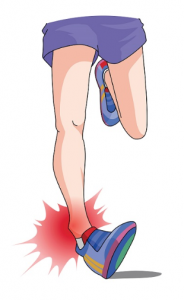Summer has ended, and we are now in the thick of fall. This season plants us right in the midst of various major league sports, and athletes everywhere are beginning to collect injuries. Most recently, Russell Westbrook of the Oklahoma City Thunder suffered what is known as the most common athletic injury of all time: the ankle sprain.
Ankle sprains occur when the ligaments of the ankle are pulled beyond their limits and overstretch or tear.  The most typical incident of an ankle sprain happens when you roll your ankle inward. Although this injury is categorized as the most common athletic injury of all time, it can happen to any ambulatory person of any background.
The most typical incident of an ankle sprain happens when you roll your ankle inward. Although this injury is categorized as the most common athletic injury of all time, it can happen to any ambulatory person of any background.
Ligaments of the ankle are of the strongest fibrous tissues in the body, and they help keep the alignment of our leg bones in proper position. When we twist or unnaturally bend our ankles, we tend to injure the lateral ligaments of our ankle the most. Fun fact: the anterior talofibular ligament is the most commonly injured ligament of the ankle.
When an ankle sprain occurs, you can expect to see swelling or bruising around the area. It can be tender to touch or walk on. If the ankle sprain is severe enough and the ligament is completely torn, the pain can be comparable to a broken bone.
To diagnose an ankle sprain, a podiatric physician would perform a physical examination that involves palpation of the ankle and testing its range of motion. Depending on the location and degree of replicated pain, your podiatrist can pinpoint the ligament damaged and its degree of damage. X-rays may be ordered to rule out bone injury.
The good news is that the majority of ankle sprains can be treated conservatively and without surgery. Most podiatrists will recommend that you give it RICE. This isn’t to be confused with the edible grain, but is an acronym for “Rest, Ice, Compression, and Elevation”.
- It is advised that you rest your injured ankle and avoid walking on it. Limit the amount of weight you place on your ankle while it is trying to heal. Ankle braces and crutches may be necessary depending on the patient.
- Ice your ankle intermittently to control the swelling, but remember to do it properly to avoid skin damage and frostbite. Do not place ice directly on the skin. Do not apply the ice for more than twenty minutes at a time.
- Add compression to the ankle to further control swelling. Be mindful of your own pain levels while compressing.
- Elevate your foot while in a comfortable seated or reclined position. It is ideal to keep the foot above the level of the heart.
Treatment of the ankle sprain can be managed at home, but if further complications arise, then make an appointment with our office today by calling 310-652-3668 at your convenience.

